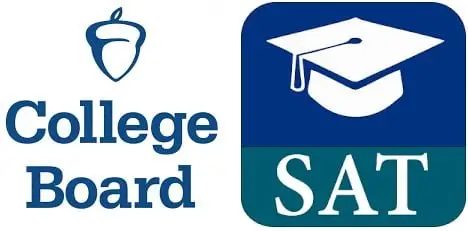Digital SAT
What is the SAT?
What is the SAT? Many colleges require scores from the SAT or ACT tests as a part of the admissions process. Your SAT score is a key component of your college applications. SAT Basics SAT Length 3 hours SAT Sections MathEvidence-Based Reading and Writing SAT Cost $55 Highest SAT Score 1600 Average SAT Score 1060 About the SAT The SAT is an entrance exam used by most colleges and universities to make admissions decisions. The SAT is a multiple-choice, pencil-and-paper test created and administered by the College Board. The purpose of the SAT is to measure a high school student’s readiness for college, and provide colleges with one common data point that can be used to compare all applicants. College admissions officers will review standardized test scores alongside your high school GPA, the classes you took in high school, letters of recommendation from teachers or mentors, extracurricular activities, admissions interviews, and personal essays. How important SAT scores are in the college application process varies from school to school. Overall, the higher you score on the SAT and/or ACT, the more options for attending and paying for college will be available to you. When should I take the SAT? Most high school students take the SAT, the ACT, or both during the spring of their junior year or fall of their senior year. It’s important to leave time to re-take the test if you need to raise your score before you apply to college. The SAT exam is offered nationally every year in August, October, November, December, March, May, and June. View all upcoming SAT test dates. What is on the SAT? There are two SAT sections: How long is the SAT? The SAT is 3 hours long. How is the SAT scored? Each section of the SAT is scored on a 200 to 800 point scale. Your total SAT score is the sum of your section scores. The highest possible SAT score is 1600. Should I take the SAT or the ACT? Most colleges and universities will accept scores from either the SAT or ACT, and do not favor one test over the other. That said, college-bound students are increasingly taking both the SAT and ACT. Changes made to the SAT in 2016 have made it easier than ever to prep for both tests concurrently—and earn competitive scores on both! The best way to decide if taking the SAT, ACT, or both tests is right for you is to take a timed full-length practice test of each type. Since the content and style of the SAT and ACT are very similar, factors like how you handle time pressure and what types of questions you find most challenging can help you determine which test is a better fit. Try our QUIZ: SAT, ACT, or Both? to learn more. How do I register for the SAT? SAT registration deadlines fall approximately five weeks before each test date. Register online on the College Board website. The College Board may require SAT registration by mail under special circumstances. How can I prep for the SAT? We can help. We have SAT prep solutions for every student and every budget. Education is the passport to the future, for tomorrow belongs to those who prepare for it today. ― Malcolm X
Educational Technology
Technological innovation is continuously shaping the future of education and changing the way people learn. In this blog, we will introduce you to the ways EdTech can assist in enhancing learning experiences in educational institutions, and improving the test results of students. Education is the passport to the future, for tomorrow belongs to those who prepare for it today. ― Malcolm X What is educational technology? Educational technology, also called EdTech, is used to communicate knowledge and enhance the education system. This can include any equipment, programs, or other resources that teachers and students utilize to facilitate learning. These technologies support students in attending their lessons, collaborating, connecting with fellow students remotely, or studying for a class. Knowingo is a unique EdTech tool that combines various elements such as gamification, AI, and learning analytics to deliver a fun, engaging, and personalised learning experience. We’ll break down its features to gain a better understanding of how it affects higher education. Does educational technology help students learn? The way students absorb information has changed drastically over time. Rather than passively listening to lecture after lecture, students prefer a more dynamic and engaging classroom setting. A national survey by PBS LearningMedia revealed 74 percent of teachers believe that technology has helped to motivate students to learn, and 69 percent say that educational technology enables teachers to “do considerably more than ever before” for their pupils. Knowingo’s smart learning platform can assist educational institutions to facilitate the changing wants and needs of students and take student learning experiences to the next level. Making education more personal Educational technology is a great tool to provide every student with a personalized learning journey. After all, each student learns and retains knowledge at a different pace. The Ebbinghaus forgetting curve represents how the information we learn fades over time and how reviews can help knowledge stick: Knowingo uses Artificial Intelligence (AI) to personalise the learning journey of students. The AI determines each student’s scoring objectives based on the user’s initial knowledge. It will present questions that match the player’s skill- and challenge level while AI also assesses attention spans and prompts play during their mental peak times. This way repetition is delivered at precise intervals. Knowledge retention is fully measurable and quantifiable through our Live Dashboard, which shows real-time data about the status of the knowledge level of users. Using AI to improve content Knowingo’s AI does not only make sure that students retain their knowledge and stay motivated to learn more, but it also helps to improve the learning content. Question Analytics is a feature enabling a comprehensive analysis of all the questions that are used in-game. It is generated by AI based on user behavior. Based on the answers of the users, each question is evaluated on 4 metrics: • Misconception: Misconception occurs when a significant segment of learners provides the same wrong answer. This metric can be used to discover where users have major misunderstandings. • Complexity: Questions are considered complex when users take more time than expected to answer them. Users might consider a question complex if it is too long, contains unknown jargon, or does not belong to the topic at hand. We recommend editing highly complex questions for better results. • Obviousness: Questions are considered obvious when users can answer correctly without any further learning. If Knowingo notices that a significant segment of the users are answering a question correctly the first time they see it, the question’s Obviousness score goes up. It may be a good idea to aim for a high Obviousness rate for some particular questions. • Error: The error score indicates if the experts seem to disagree with the correct answer to this question. When the majority of experts on a topic pick the same wrong answer, it is extremely likely that there are issues with the question, or that the wrong answer that the experts have chosen is actually the correct one. If that is the case, we recommend editing the question at hand. Learning on the go with mobile learning Mobile learning gives students the flexibility to learn from anywhere, at any time. Not only is it time-effective, but it also frees students from spending hours sitting behind a desk. Educational technology allows for self-paced learning and gives users a sense of control. They can access the learning materials whenever it is most convenient for them. On the train, on the bus, or from the comfort of your bed, Knowingo can be played anywhere, anytime! Gamified learning increases student engagement Due to the engaging way the study material is delivered, students feel challenged to keep learning to improve their past scores. Gamified learning can help students to learn and retain info where other traditional learning solutions fall short. It makes studying for exams fun, and it boosts motivation as well as student engagement. With Knowingo, students are also able to test each other’s knowledge in a battle. This competitive game mode motivates students to perform better and keep up with their classmates. The benefits of gamified mobile learning for lecturers Gamification can help draw students’ attention, motivate them to work harder, and give them incentives to complete their coursework on time so they don’t fall behind in class. Knowingo turns course materials into topics that can be finished in 20-30 minutes. Using games and simulations helps students practice and retain what they’ve learned, and it also keeps them engaged with their coursework. Motivated students participate better in class and are less likely to cause a distraction to both the lecturer and fellow students, making teaching more pleasant. Both mobile learning and gamification are ways that lecturers in higher education can make their courses more engaging for students—and both are great ways of improving student engagement across all courses! Educational technology provides valuable insights into student development Online learning platforms allow insight into the learning progress of users in ways traditional learning methods cannot. Regularly tracking student progress gives the instructor the opportunity to analyze each student’s present performance level and monitor their progress over the course of the academic year. With Knowingo, teachers can track the
Introducing EST 1 & EST 2
EST is a standardized admission test, scored electronically. EST is owned by Academic Assessment Ltd. in London. EST is validated by the EST Board in the USA. It is designed specifically to measure the skills and knowledge acquired by students. EST is scored and delivered in collaboration with Pearson, the world’s largest education company. EST seeks to embody and implement the most sophisticated, up-to-date assessment with a suite of assessments that includes EST I and EST II. EST I includes three mandatory sections: Reading, Writing and Language, and Mathematics. EST I tackles communication skills, comprehension, critical and logical reasoning; all these are basic requirements for a university student. The EST I also includes an optional essay section measuring students’ language writing skills. The EST II is a subject-based test in Science and Math. The EST subject tests cover Math, Biology, Physics, and Chemistry, with each subject test taken separately. The EST II measures basic scientific knowledge, scientific reasoning, and higher-order thinking skills, proving the abilities and capabilities of the student to pursue education in specific majors related to engineering, science and health care. The choice of subject tests depends on the majors the students are applying for. Education is the passport to the future, for tomorrow belongs to those who prepare for it today. ― Malcolm X How to improve knowledge skills Lorem ipsum dolor sit amet, consectetur adipisicing elit, sed do eiusmod tempor incididunt ut labore et dolore magna aliqua. Ut enim ad minim veniam, quis nostrud exercitation ullamco laboris nisi ut aliquip ex ea commodo consequat. Duis aute irure dolor in reprehenderit in voluptate velit esse cillum dolore eu fugiat nulla pariatur. Excepteur sint occaecat cupidatat non proident, sunt in culpa qui officia. The positive power of education Lorem ipsum dolor sit amet, consectetur adipisicing elit, sed do eiusmod tempor incididunt ut labore et dolore magna aliqua. Ut enim ad minim veniam, quis nostrud exercitation ullamco laboris nisi ut aliquip ex ea commodo consequat. Duis aute irure dolor in reprehenderit in voluptate velit esse cillum dolore eu fugiat nulla pariatur. Excepteur sint occaecat cupidatat non proident, sunt in culpa qui officia.
A Critical Review of Mobile Learning Integration
Mobile learning integration has gained significant attention in recent years as mobile devices become increasingly prevalent and accessible. While there are notable benefits associated with mobile learning, it is crucial to critically examine the integration process and its implications. This review will assess the advantages and potential challenges of mobile learning integration. One of the key advantages of mobile learning integration is the flexibility it offers. Mobile devices allow learners to access educational materials anytime and anywhere, enabling a personalized and self-paced learning experience. This flexibility can enhance engagement and motivation among learners, as they can choose when and where to engage with the content. Furthermore, mobile learning integration can leverage the interactive and multimedia capabilities of mobile devices. Educational apps, videos, and simulations can provide immersive and engaging learning experiences. This approach caters to different learning styles and promotes active learning, which can lead to better retention and understanding of the material. Another benefit is the potential for collaborative learning. Mobile devices enable communication and collaboration among learners, allowing them to engage in group projects, discussions, and knowledge sharing. This social aspect of mobile learning can foster a sense of community and facilitate peer-to-peer learning, enhancing the overall learning experience. Education is the passport to the future, for tomorrow belongs to those who prepare for it today. ― Malcolm X However, several challenges need to be considered when integrating mobile learning. One significant challenge is the digital divide. Despite the increasing accessibility of mobile devices, not all learners have equal access to technology or reliable internet connections. This disparity can create an inequitable learning environment, where some students may be left behind due to limited access to mobile devices or connectivity issues. Another challenge is the distraction factor. Mobile devices are multifunctional, and learners may face temptations to engage in non-educational activities, such as social media or gaming, during learning sessions. This can hinder concentration and negatively impact learning outcomes. Educators must find effective strategies to mitigate distractions and promote focused learning. Additionally, there may be concerns about the quality and reliability of educational content available on mobile devices. With the vast array of mobile apps and resources, ensuring the accuracy and credibility of the content becomes crucial. Educators need to curate and evaluate mobile learning materials to ensure their relevance and educational value. Furthermore, integrating mobile learning requires professional development for educators. They need to be proficient in leveraging mobile technologies effectively and incorporating them into instructional strategies. Without adequate training and support, educators may struggle to utilize mobile learning to its full potential. In conclusion, mobile learning integration offers numerous advantages such as flexibility, interactivity, and collaboration. However, challenges related to the digital divide, distractions, content quality, and educator training must be addressed. By addressing these challenges, mobile learning integration can be a powerful tool for enhancing educational experiences and promoting lifelong learning. How to improve knowledge skills Improving knowledge skills is a continuous process that involves various strategies and approaches. Here are some effective ways to enhance your knowledge skills: Remember that improving knowledge skills is a gradual process, and consistency is key. Embrace a growth mindset, stay curious and open-minded, and actively seek opportunities to expand your knowledge in various domains.
How to Learn English Fast and Easy
Learning English fast and easy requires a combination of effective strategies and consistent effort. Here are some tips to help you learn English more efficiently: Remember that learning a language takes time and effort. Be patient with yourself and celebrate your progress along the way. Enjoy the process of learning English and stay motivated by setting achievable goals and maintaining a positive attitude. Education is the passport to the future, for tomorrow belongs to those who prepare for it today. ― Malcolm X
How to Learn Faster and Remember
Learning faster and improving your memory can be achieved through various techniques and strategies. Here are some tips to help you learn more efficiently and enhance your memory retention: Remember, everyone learns differently, so it’s important to experiment with these strategies and adapt them to your own learning style. Be patient with yourself and stay motivated. Learning and memory improvement are skills that can be developed with practice and perseverance. Education is the passport to the future, for tomorrow belongs to those who prepare for it today. ― Malcolm X
Free Online Courses from Top Universities
There are several top universities and educational platforms that offer free online courses, often referred to as Massive Open Online Courses (MOOCs). Here are some popular platforms where you can find a wide range of courses from esteemed universities: These platforms are a great starting point to explore free online courses from top universities. Keep in mind that while the courses are free, there may be fees associated with receiving certificates or pursuing verified tracks. Additionally, the availability and selection of courses may vary over time, so it’s advisable to check the platforms for the most up-to-date offerings. Education is the passport to the future, for tomorrow belongs to those who prepare for it today. ― Malcolm X
Learn Exactly How I Improved Education
Improving education is a complex and multifaceted endeavor that involves the collaboration of various stakeholders, including policymakers, educators, parents, and communities. While there is no one-size-fits-all approach to improving education, here are some key strategies that can contribute to positive changes: Remember, improving education is an ongoing process that requires continuous evaluation, adaptation, and collaboration. It is essential to consider the unique needs and contexts of the education system you are working with and involve all stakeholders in the decision-making process. Education is the passport to the future, for tomorrow belongs to those who prepare for it today. ― Malcolm X
What Everyone Must Know About Education
Education is a fundamental aspect of human development and plays a crucial role in shaping individuals, societies, and the world at large. Here are some key points that everyone should know about education: Understanding these aspects of education helps individuals appreciate its importance, advocate for quality education for all, and actively participate in their own learning journey and educational initiatives. Education is the passport to the future, for tomorrow belongs to those who prepare for it today. ― Malcolm X













